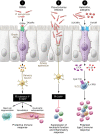Brush cells fine-tune neurogenic inflammation in the airways
- PMID: 35775485
- PMCID: PMC9246375
- DOI: 10.1172/JCI161439
Brush cells fine-tune neurogenic inflammation in the airways
Abstract
Airway epithelial cells, once considered a simple barrier layer, are now recognized as providing an active site for antigen sensing and immune response initiation. Most mucosal sites contain chemosensory epithelial cells, rare and specialized cells gaining recognition for their unique functions in sensing and directing the immune response symphony. In this issue of the JCI, Hollenhorst, Nandigama, et al. demonstrated that tracheal chemosensory brush cells detected bitter-tasting substances, including quorum-sensing molecules (QSMs) generated by pathogenic Pseudomonas aeruginosa. The authors used various techniques, including genetic deletion of brush cells, genetic manipulation of brush cell signaling, deletion of sensory neurons, in vivo imaging, and infection models with P. aeruginosa, to show that QSMs increased vascular permeability and innate immune cell influx into the trachea. These findings link the recognition of bacterial QSMs to the innate immune response in the airways, with translational implications for airway inflammation and infectious pathology.
Conflict of interest statement
Figures

Comment on
-
Bitter taste signaling in tracheal epithelial brush cells elicits innate immune responses to bacterial infection.J Clin Invest. 2022 Jul 1;132(13):e150951. doi: 10.1172/JCI150951. J Clin Invest. 2022. PMID: 35503420 Free PMC article.

